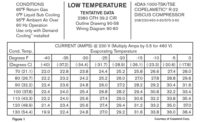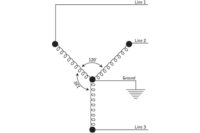
|
| John Tomczyk |
Have you ever wondered why some low-voltage (115-V) power-consuming devices burn out too often? It could be because they are wired to a “high” or “wild” power leg of a voltage supply. These devices are actually receiving too high of a voltage to operate for any prolonged period of time. This column will try to explain the voltages associated with the high or wild leg coming from the secondary of a Delta service transformer. The high or wild leg of a service transformer is only associated with a Delta transformer.
Many commercial buildings have electrical power delivered by means of dual-voltage, 60-Hz service. One example would be a 120/240-V, three-phase, 4-wire Delta drop. The secondary of the Delta transformer (Figure 1, page 27) delivers power to a building. Remember, the secondary of these transformers receive their voltage from the primary windings (not shown in Figure 1) of the transformer through induced voltage. Any time a Delta transformer’s secondary winding is center tapped, a high leg is created. Notice that one of the windings of the Delta transformer has been center tapped and connected to earth ground. This center tap is connected to a ground rod driven into the earth, which grounds the neutral wire and the equipment’s chassis.
Single-phase voltages can be picked off the secondary of the Delta transformer. Listed here are those single-phase voltages:
A to B – 240 V
A to C – 240 V
B to C – 240 V
A to N – 120 V
B to N – 120 V
Notice that when the winding of the transformer was center tapped to ground, it divided the total winding voltage (240 V) into two 120-V windings connected in series. This happened because the winding was divided perfectly in half. Both phase A and phase B, relative to the center tap or ground, would be 120 V, and could be used for any single-phase, 120-V sources. If all three phases or legs (A, B, and C) of the Delta transformer were used, 240-V three-phase power can be used.
The Odd or High Voltage
What would the voltage be from leg C to leg N? This would be the power leg to ground. The power leg referenced to the center tap or ground would consist of one entire winding and half of another winding with an angle in the middle of the two windings (Figure 2). The voltage between phase C and N is neither 240 V nor 120 V. It is an odd voltage that usually has a value between 200-210 V single-phase. The actual voltage of this odd or high voltage will vary depending on the turn ratio of the transformer’s primary and secondary windings. This is why phase C is referred to as the power leg or high leg. The power leg is usually colored orange so it can be readily recognized.
Never wire the power leg to a 120-V source. It should only be used on 240-V three-phase loads or 240-V single-phase loads. If it is used on a 120-V single-phase load, the load will eventually fail from too high of a voltage source. Notice that the power leg only has this odd voltage when it is referenced to ground. Again, this is because it is working through the entire winding and another half winding with an angle in between. This does not hold true for phase B and phase A, referenced to ground. They simply split the one winding between phase A and B in half.
Publication date: 3/3/2014
Want more HVAC industry news and information? Join The NEWS on Facebook, Twitter, and LinkedIn today!












